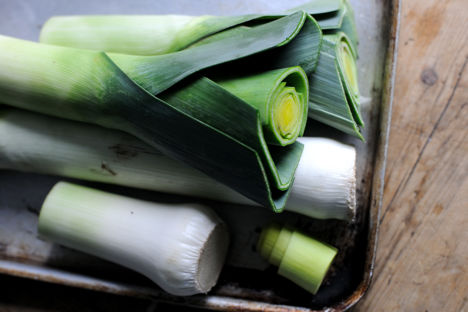
Super leek: new ways with Wales’ favourite vegetable
Leeks might be a staple ingredient in the UK, but they're just as popular all around the world. Discover some of the more exotic dishes where this humble vegetable takes centre stage.
Super leek: new ways with Wales’ favourite vegetable
Leeks might be a staple ingredient in the UK, but they're just as popular all around the world. Discover some of the more exotic dishes where this humble vegetable takes centre stage.
Mild, sweet and oniony, leeks have enjoyed a prime spot in the world of British vegetables for centuries. They’re an important part of our chicken pies, play a significant role in our soups and, when creamed, make the perfect side to a Sunday roast. The humble allium is even the national emblem of Wales and associated with Saint David (the country’s patron saint), as supposedly an ancient Welsh king ordered his soldiers to identify themselves by strapping a leek to their helmets before a big battle.
It’s no wonder then that we tend to associate leeks with our own cuisine instead of treating it as a more international ingredient. However, they’re just as important in food cultures all over the world, as they’re easy to grow, pleasantly flavoured and incredibly versatile. Here, we take a look at five other countries which make the most of leeks in all sorts of different dishes – give them a try at home and discover how well they can adapt to various cuisines.
Around the world
Leeks (pirasa) are pretty well ingrained into Turkish culture. They tend to be either loved or hated, inspiring a famous Turkish band called Baba Zula to title one of their songs Pirasa. A phrase common amongst Albanian Turks when they’re too full of food also roughly translates to ‘I couldn’t eat anymore, even if I was offered a leek’.
A classic Turkish dish is zeytinyagli pirasa, which is a simple combination of leeks, carrots and rice dressed in plenty of olive oil. They’re also commonly served in a slow-cooked stew with tomatoes, garlic, lemon, onion and plenty of herbs, then left to cool to room temperature to be enjoyed as part of a mezze. Other dishes are just as simple, often lightly cooking thick slices of leeks with nothing more than lemon and olive oil.
Leek is a key component of one of Scotland’s most famous soups, Cock a leekie, but it’s also the main ingredient in France’s national soup, the vichyssoise. This classic combination of leeks, potatoes, cream and chicken stock all puréed together is traditionally served cold, and was derived from the more common leek and potato soup.
The French also love leeks vinaigrette, poaching the vegetable before dressing it in plenty of mustard, oil and vinegar. For a more intricate leek dish, flamiche is a very popular delicacy found in both France and French-speaking parts of Belgium. It’s essentially a leek tart that resembles a quiche but with a brioche-based pastry.
The Spanish love their leeks (or puerros) and they’re a popular addition to a Spanish tortilla. They’re also favoured in the Basque country, where the porrusalda, a simple leek, carrot and potato broth, is used as a base for serving pieces of salted cod, sausage or eggs. Baby leeks are also a favourite for the barbecue, where they are grilled whole and then dipped in Romesco sauce, much like another Catalonian delicacy, the calçot.
The Greeks absolutely love leeks, eating them throughout the year; their word for ‘light green’ is even derived from the vegetable’s name. Instead of being added to sauces or soups, they’re usually left whole, cooked in white wine, lemon and thyme, resulting in a sweet dish that’s served with lots of nice crusty bread. Prasopita jazzes the vegetable up a bit, mixing sliced leeks with feta and wine in a cream sauce and covering it in filo pastry to make one of the country’s favourite pies.
Leeks are just as popular outside of Europe; Sri Lanka consumes a huge number and includes them in many of its national dishes. It is almost always combined with fragrant spices and served either dry or in a rich curry sauce. Leeks mirisata is a fish and leek side dish, thel dala combines finely shredded leeks with chilli and garlic, and varar combines the vegetable with cabbage, coconut and spices.


